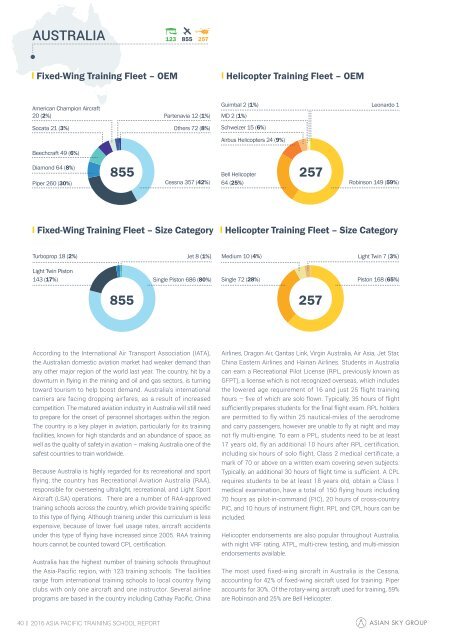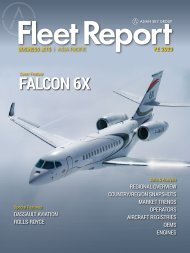You also want an ePaper? Increase the reach of your titles
YUMPU automatically turns print PDFs into web optimized ePapers that Google loves.
AUSTRALIA<br />
123 855<br />
257<br />
Fixed-Wing <strong>Training</strong> Fleet – OEM<br />
Helicopter <strong>Training</strong> Fleet – OEM<br />
American Champion Aircraft<br />
20 (2%) Partenavia 12 (1%)<br />
Socata 21 (3%)<br />
Beechcraft 49 (6%)<br />
Diamond 64 (8%)<br />
Piper 260 (30%)<br />
42+30+8+8+6+3+2+1+G<br />
Others 72 (8%)<br />
Guimbal 2 (1%)<br />
MD 2 (1%)<br />
Schweizer 15 (6%)<br />
Airbus Helicopters 24 (9%)<br />
59+25+10+4+1+1+0+0+G<br />
855 257<br />
Leonardo 1<br />
Bell Helicopter<br />
Cessna 357 (42%) 64 (25%)<br />
Robinson 149 (59%)<br />
Fixed-Wing <strong>Training</strong> Fleet – Size Category<br />
Helicopter <strong>Training</strong> Fleet – Size Category<br />
79+18+2+1+G<br />
62+30+5+3+G<br />
Turboprop 18 (2%) Jet 8 (1%) Medium 10 (4%)<br />
Light Twin 7 (3%)<br />
Light Twin Piston<br />
143 (17%) Single Piston 686 (80%) Single 72 (28%)<br />
Piston 168 (65%)<br />
855 257<br />
According to the International Air Transport Association (IATA),<br />
the Australian domestic aviation market had weaker demand than<br />
any other major region of the world last year. The country, hit by a<br />
downturn in flying in the mining and oil and gas sectors, is turning<br />
toward tourism to help boost demand. Australia’s international<br />
carriers are facing dropping airfares, as a result of increased<br />
competition. The matured aviation industry in Australia will still need<br />
to prepare for the onset of personnel shortages within the region.<br />
The country is a key player in aviation, particularly for its training<br />
facilities, known for high standards and an abundance of space, as<br />
well as the quality of safety in aviation – making Australia one of the<br />
safest countries to train worldwide.<br />
Because Australia is highly regarded for its recreational and sport<br />
flying, the country has Recreational Aviation Australia (RAA),<br />
responsible for overseeing ultralight, recreational, and Light Sport<br />
Aircraft (LSA) operations. There are a number of RAA-approved<br />
training schools across the country, which provide training specific<br />
to this type of flying. Although training under this curriculum is less<br />
expensive, because of lower fuel usage rates, aircraft accidents<br />
under this type of flying have increased since 2005. RAA training<br />
hours cannot be counted toward CPL certification.<br />
Australia has the highest number of training schools throughout<br />
the Asia-Pacific region, with 123 training schools. The facilities<br />
range from international training schools to local country flying<br />
clubs with only one aircraft and one instructor. Several airline<br />
programs are based in the country including Cathay Pacific, China<br />
Airlines, Dragon Air, Qantas Link, Virgin Australia, Air Asia, Jet Star,<br />
China Eastern Airlines and Hainan Airlines. Students in Australia<br />
can earn a Recreational Pilot License (RPL, previously known as<br />
GFPT), a license which is not recognized overseas, which includes<br />
the lowered age requirement of 16 and just 25 flight training<br />
hours – five of which are solo flown. Typically, 35 hours of flight<br />
sufficiently prepares students for the final flight exam. RPL holders<br />
are permitted to fly within 25 nautical-miles of the aerodrome<br />
and carry passengers, however are unable to fly at night and may<br />
not fly multi-engine. To earn a PPL, students need to be at least<br />
17 years old, fly an additional 10 hours after RPL certification,<br />
including six hours of solo flight, Class 2 medical certificate, a<br />
mark of 70 or above on a written exam covering seven subjects.<br />
Typically, an additional 30 hours of flight time is sufficient. A CPL<br />
requires students to be at least 18 years old, obtain a Class 1<br />
medical examination, have a total of 150 flying hours including<br />
70 hours as pilot-in-command (PIC), 20 hours of cross-country<br />
PIC, and 10 hours of instrument flight. RPL and CPL hours can be<br />
included.<br />
Helicopter endorsements are also popular throughout Australia,<br />
with night VRF rating, ATPL, multi-crew testing, and multi-mission<br />
endorsements available.<br />
The most used fixed-wing aircraft in Australia is the Cessna,<br />
accounting for 42% of fixed-wing aircraft used for training. Piper<br />
accounts for 30%. Of the rotary-wing aircraft used for training, 59%<br />
are Robinson and 25% are Bell Helicopter.<br />
40 | 2016 ASIA PACIFIC TRAINING SCHOOL REPORT

















